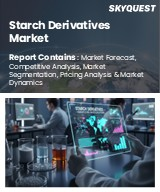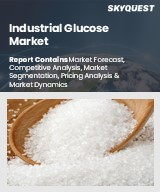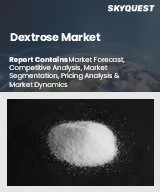
|
시장보고서
상품코드
1829448
글루코오스, 덱스트로스, 말토덱스트린 시장 : 제품 유형별, 형상별, 등급별, 프로세스별, 포장 유형별, 용도별, 유통 채널별 - 세계 예측(2025-2032년)Glucose, Dextrose, & Maltodextrin Market by Product Type, Form, Grade, Process, Packaging Type, Application, Distribution Channel - Global Forecast 2025-2032 |
||||||
글루코오스·덱스트로스·말토덱스트린 시장은 2032년까지 CAGR 7.74%로 915억 9,000만 달러로 성장할 것으로 예측됩니다.
| 주요 시장 통계 | |
|---|---|
| 기준연도 2024 | 504억 2,000만 달러 |
| 추정연도 2025 | 543억 달러 |
| 예측연도 2032 | 915억 9,000만 달러 |
| CAGR(%) | 7.74% |
원료의 기능성, 공급망, 진화하는 최종 용도 요구사항이 전체 밸류체인의 전략적 우선순위를 어떻게 재구성하고 있는지를 간결한 맥락에서 설명
글루코오스·덱스트로스·말토덱스트린의 세계 원료 상황은 원료 배합자와 다운스트림 생산자가 소비자의 선호도 변화, 규제 상황의 복잡성, 공급망 불안정성에 직면하면서 변곡점을 맞이하고 있습니다. 이러한 주식용 탄수화물 원료는 베이커리 제품부터 고부가가치 의약품 부형제까지 다양한 제품을 지원하고 있으며, 그 성능 프로파일(단맛, 용해성, 흡습성, 기능성 입맛)은 다양한 산업 분야에서 필수적인 역할을 하고 있습니다. 한편, 가공업체들은 효율성과 규정 준수에 투자하여 비용 압박과 추적성 및 제품 출처에 대한 기대치가 높아지는 것과 균형을 맞추기 위해 노력하고 있습니다.
과거 공급 패턴에서 벗어나 업계 관계자들은 물류를 최적화하고 최종 용도의 요구 사항을 충족시키기 위해 공정 선택, 등급 사양, 포장 형태에 점점 더 많은 초점을 맞추었습니다. 동시에 업계는 직접적인 상거래 관계, 유통업체와의 파트너십, 디지털 상거래가 교차하는 채널 역학의 변화에 대응하고 있습니다. 본 Executive Summary는 구조적 변화, 관세 주도형 파괴, 세분화 정보, 지역적 역학, 경쟁적 행동, 실천적 제안, 그리고 이러한 인사이트을 지원하는 방법론적 토대를 통합하고 있습니다.
수요의 고도화, 조달의 복잡성, 가공 기술 혁신의 수렴이 공급망 전반의 전략적 변화를 어떻게 촉진하고 있는가?
포도당-덱스트로스-말토덱스트린을 둘러싼 환경은 수요 측면의 고도화, 조달의 복잡성, 가공의 혁신이라는 세 가지 수렴적인 힘에 의해 변화하고 있습니다. 수요 측면의 고도화는 식품 및 음료 처방자들이 기능적 성능과 함께 성분의 투명성을 요구하고, 공급업체가 추적성을 강화하고 특정 용도에 맞는 제품 등급을 차별화하도록 유도하고 있다는 점에서 분명하게 드러납니다. 원자재 투입, 물류 능력, 무역 정책 등이 복합적으로 작용하여 불균등한 비용 압박을 야기하고 있으며, 소싱의 복잡성이 증가하고 있습니다. 기업은 공급업체 네트워크를 다양화하고, 유상 생산 모델과 상인 생산 모델을 재평가함으로써 적응하고 있습니다.
가공 기술 혁신은 현재 에너지와 물 사용량을 줄이면서 식품 등급과 의약품 등급의 요구 사항을 모두 충족시키기 위해 가수분해 경로와 하류 정제를 미세 조정하는 데 초점을 맞추었습니다. 효소 가수분해의 채택은 제품 품질과 지속가능성 주장이 가장 중요한 분야에서 증가하고 있으며, 산 가수분해는 비용과 규모가 지배적인 분야에서 여전히 중요합니다. 동시에 포장 및 유통 모델도 진화하고 있습니다. 소매에 적합한 봉지에 대한 수요는 산업 고객을위한 대량 주문과 공존하고 있으며, E-Commerce는 특수하고 틈새 채널에서 더 명확한 역할을 수행하고 있습니다. 이러한 변화는 총체적으로 새로운 경쟁 행동과 전략적 재조합을 촉진하고 있습니다.
최근 관세 조치로 인해 업계 전반의 조달 인센티브, 업무 대응, 계약 방식이 어떻게 달라졌는지 이해
2025년 중 미국에서 도입된 관세는 조달, 가격 책정 행동, 공급업체 선정에 파급되는 누적된 무역과 비용의 현실을 만들어냈습니다. 수입 관세로 인해 특정 가공업체들의 육류 하역 비용이 변화하고, 바이어들이 조달 전략을 재검토하고, 생산 능력과 물류 발자국이 국경 조정의 영향을 덜 받는 국내 공급업체와 지역 공급업체에 대한 관심을 가속화했습니다. 이에 따라 각 제조업체는 장기 계약을 재검토하고 이중 조달을 우선시하며, 운송 시간과 비용의 변동을 완화하기 위해 재고 버퍼를 늘리고 있습니다.
한 가공업체는 외부의 충격으로부터 핵심 생산을 보호하기 위해 국내 통관 절차를 확대했고, 또 다른 가공업체는 고가의 수입 원료를 보다 효율적으로 사용하기 위해 배합을 최적화했습니다. 규제 준수 및 문서화 요구 사항도 더욱 두드러져 관리 부담을 증가시키고 공급업체의 채택 결정에 영향을 미쳤습니다. 마지막으로 관세는 원자재 공급업체와 최종사용자 간의 긴밀한 상업적 협력의 가치를 높이고, 기업이 예측 가능한 마진과 탄력적인 공급망을 추구함에 따라 계약 조항, 패스스루 메커니즘, 가치 공유 계약이 더욱 보편화되었습니다.
제품 유형, 형태, 등급, 공정, 포장, 용도, 유통의 선택이 어떻게 상업적, 기술적 우선순위를 결정하는지를 보여주는 상세한 세분화 분석
세분화는 제품 유형, 형태, 등급, 가공 경로, 포장 선택, 용도, 유통 경로가 각각 다른 기술적, 상업적 의미를 갖기 때문에 전략의 원동력이 됩니다. 덱스트로스-포도당-말토덱스트린의 제품 유형별 구분은 단맛 프로파일, 덱스트로스 당량, 식감 및 보존성에서 기능적 역할을 결정하여 처방 담당자가 특정 용도에 가장 적합한 탄수화물을 선택할 수 있도록 도와줍니다. 분말이든 시럽이든 제형의 편리성, 취급 및 운송에 직접적인 영향을 미치는 것은 모양이며, 시럽은 액체 처리 라인을 선호하고, 분말은 복용량 유연성과 저장 안정성을 연장시킵니다.
식품 등급과 의약품 등급의 구분은 품질관리 체계, 문서화 요구 사항, 정제 및 클린룸 인프라에 대한 설비 투자에 차이를 가져옵니다. 산 가수분해와 효소 가수분해라는 공정 구분은 불순물 프로파일, 에너지 강도, 제품 차별화 가능성에 영향을 미치며, 제품별 수준이 낮기 때문에 효소 경로가 고급 용도로 선택되는 경향이 강해지고 있습니다. 봉지, 벌크 용기, 드럼통, 1회용 봉지 등 포장의 유형은 독특한 비용 대비 제공량 역학을 생성하고 채널 적합성에 영향을 미칩니다. 동물 사료, 화장품 및 퍼스널케어는 일관된 기능적 성능과 규제 준수가 요구되는 반면, 식품 및 음료 용도는 베이커리, 음료, 제과, 유제품 및 냉장식품, 영양 보충제, 스낵, 베이커리에서는 빵과 롤케이크, 케이크, 쿠키 및 비스킷에 대한 명확한 요구가 있습니다. 과자류에는 초콜릿, 구미, 젤리, 토피, 캐러멜 등이 있으며, 특유의 템퍼링과 결정화를 고려해야 합니다. 유제품과 냉장 과자에는 치즈, 아이스크림, 요구르트 등이 있으며, 안정성과 관능적 요구가 다릅니다. 건강기능식품에는 라벨 표시와 성분의 상호작용이 중요한 건강기능식품과 에너지바가 포함되며, 스낵은 타겟 기능적 특성이 요구되는 향미조미료와 감미료로 나뉩니다. 마지막으로 직접 판매, 대리점, E-Commerce와 같은 유통 채널은 고객과의 친밀감, 리드타임, 마진 구조를 형성하므로 공급업체는 다양한 고객 부문과 이용 사례에 따라 상업 모델을 조정해야 합니다.
이러한 세분화 축을 종합하면 투자 우선순위, 연구개발 중점, 판매 전략이 도출되고, 기업이 가공 기술, 포장 라인, 상업 팀에 자본을 어떻게 배분할 것인지 결정합니다.
지역별 상이한 수요 패턴, 규제 체계, 공급망 구조가 조달 전략과 투자 우선순위를 어떻게 형성하고 있는가?
지역 역학은 지역적 정보에 기반한 전략을 필요로 하는 형태로 조달, 수요 패턴, 투자 흐름을 재편하고 있습니다. 아메리카 지역에서는 기존의 가공 기지와 통합된 설탕 공급망이 원료에 대한 안정적인 접근을 지원하고 있지만, 생산자들은 지속가능성 증명에 대한 감시가 강화되고 포장 및 형태 최적화에 대한 관심이 높아지면서 물류적 제약에 직면하고 있습니다. 이 지역 수요는 식품 및 음료 하위 부문뿐만 아니라 영양 보충제 및 퍼스널케어 분야로 확대되고 있으며, 공급업체는 개별 요구에 맞는 제품 등급과 서비스 모델을 제공해야 하는 상황에 직면해 있습니다.
유럽, 중동 및 아프리카에서는 규제 프레임워크와 식품 안전 체제로 인해 진입장벽이 높고, 컴플라이언스 문서화 및 추적성을 중요하게 여깁니다. 이러한 광범위한 지역에 걸친 물류의 복잡성은 지역별 창고와 연포장 형태에 대한 가치를 높이고 있습니다. 아시아태평양은 여전히 가장 크고 가장 이질적인 성장의 장으로, 산업 식품 사업의 대량 수요와 빠르게 진화하는 소매 및 E-Commerce 생태계가 결합되어 있습니다. 현지 생산 능력에 대한 투자, 가공 경로에 대한 기술 이전, 지역 유통업체와의 제휴는 다양한 고객 부문에 걸쳐 서비스 비용을 관리하면서 다양한 용도의 요구를 충족시키기 위한 일반적인 전략입니다.
규모화, 전문화, 공동개발을 통해 경쟁 우위를 재정의하고 원료 산업에서 차별화된 가치 제안을 가능하게 하는 방법
경쟁력은 규모 중심의 효율성, 기술 중심의 차별화, 상업적 모델 혁신의 조합으로 재정의되고 있습니다. 업계를 선도하는 원료 가공 기업은 업스트림 원료 조달, 공장내 가수분해 능력, 다운스트림 제제 지원 등 수직적 통합을 활용하여 비용 우위를 확보하고 대규모 산업 고객을 위한 통합 솔루션을 제공합니다. 동시에 전문 공급업체는 고순도 의약품 등급 제품, 효소로 제조된 특수 시럽, 특정 식감 및 유통기한에 맞는 맞춤형 말토덱스트린 프로파일 등 틈새 가치 제안에 초점을 맞추었습니다.
공급업체와 다운스트림 브랜드 간의 전략적 파트너십과 공동 개발 계약이 더욱 현실화되어 제형 안정성, 클린 라벨 선언, 비용 효율적인 리포뮬레이션에 대한 공동 문제 해결에 중점을 두게 되었습니다. 생산 유연성에 대한 투자를 통해 공급업체는 수요 변화에 따라 분말과 시럽의 생산량을 전환하거나 식품 등급과 의약품 등급 라인 간에 생산 능력을 할당할 수 있습니다. 한편, 신규 진출기업이나 틈새 시장 기업의 경우, 제조 도급업체나 토링 프로바이더는 그린필드 건설에 필요한 자본 집약 없이도 생산 능력을 제공할 수 있는 매우 중요한 역할을 합니다. 전체 경쟁 환경에서는 운영의 강인함과 제품 및 서비스 차별화를 모두 갖춘 기업이 새로운 기회를 포착하는 데 가장 유리한 위치에 있습니다.
회복탄력성과 수익성을 강화하기 위해 조달, 운영, 제품 개발 및 상업 팀이 실행해야 할 기능 간, 기능별, 실용적인 전략적 조치들
업계 리더는 인사이트를 경쟁 우위로 전환하기 위해 6가지 실천적 행동을 우선적으로 실행해야 합니다. 조달 및 계약 전략을 다양화하여 단일 원산지 리스크에 대한 노출을 줄이고 협상력을 강화합니다. 제품 등급과 비용을 고려하여 효소 가수분해와 산 가수분해를 전환할 수 있는 유연한 가공에 투자하고, 식품 안전과 의약품 컴플라이언스에 대한 기대치가 높아짐에 따라 품질 시스템과 추적성을 강화합니다. 전략적 고객과의 직접적인 거래 관계를 강화하는 한편, 도달 범위와 탄력성을 위해 유통업체와 E-Commerce 채널을 유지합니다.
이러한 제안을 실행하기 위해서는 조달, 운영, R&D, 상업 부문에 걸친 협력적 행동이 필요합니다. 단기적인 승리는 공급 계약 재협상, 재고 버퍼의 최적화, 기존 생산 능력을 수익성이 높은 등급으로 재분배함으로써 얻을 수 있는 경우가 많습니다. 중기적으로는 자동화, 프리미엄급 정제 업그레이드, 대상 포장의 현대화를 우선적으로 투자해야 합니다. 장기적으로는 지속가능성 보고에 대한 역량 강화, 공급업체 개발 프로그램, 밸류체인 전반의 추적성 및 수요 파악을 개선하는 디지털 툴 등 다양한 노력이 필요합니다.
이해관계자 인터뷰, 프로세스 분석, 2차 검증을 통합한 엄격한 혼합 방법론 조사 프레임워크를 통해 신뢰할 수 있고 실행 가능한 인사이트를 보장
본 분석은 1차 관계자 인터뷰, 상세한 프로세스 매핑, 그리고 체계적인 2차 자료 검증을 결합한 혼합 연구 접근법을 종합한 것입니다. 1차 입력에는 원료 가공업체, 식품 및 음료 카테고리 배합사, 조달 리더, 포장 전문가, 유통 파트너와의 구조화된 인터뷰가 포함되어 실제 업무 제약, 품질 우선순위, 상업적 선호도를 파악할 수 있었습니다. 산 가수분해와 효소 가수분해의 두 경로에 대한 프로세스 매핑을 수행하여 주요 비용 동인, 불순물 벡터, 자본 강도의 차이를 식별하고 이러한 기술적 평가를 공장 수준의 실무자와 교차 확인했습니다.
2차 정보 검증은 일반에 공개된 규제 지침, 무역 정책 발표, 물류 데이터, 지역 무역 및 관세 영향을 검증하고, 자체 공급업체 문서 및 제품 사양서에서 등급과 용도의 정의를 정교화했습니다. 조사 기간 중 전문가 패널은 조사 결과를 반복적으로 검토하여 타당성을 검증하고, 서로 다른 입력 사항을 조정하고, 결론이 이론적 전제조건이 아닌 운영 현실을 반영하는지 확인했습니다. 이 접근 방식은 투명성, 정보 출처의 추적 가능성, 의사결정자에게 실용적인 인텔리전스에 중점을 두었습니다.
다양한 최종 용도, 탄력성, 차별화, 비즈니스 우선순위의 간결한 통합을 통해 성공하는 기업을 결정
요약하면, 포도당-덱스트로스-말토덱스트린은 많은 산업 밸류체인에서 전략적 위치를 차지하고 있으며, 소비자의 기대, 가공 방법의 선택, 지역 무역의 현실, 유통의 진화가 서로 영향을 미치면서 경쟁 경제가 재정의되고 있습니다. 가공 경로, 포장 형태, 상업적 모델을 용도별 요구사항에 맞게 조정하는 기업은 최대 가치를 창출하는 반면, 추적성, 규제 준수, 채널별 서비스 모델을 소홀히 하는 기업은 비즈니스 마찰과 기회 손실이 발생할 수 있습니다.
즉, 공급처를 다양화하고, 가공의 유연성을 높이고, 품질과 포장의 업그레이드에 선택적으로 투자하는 것입니다. 동시에 기업은 고순도 등급, 더 깨끗한 가공 방법, 다운스트림 파트너와의 긴밀한 통합을 통해 차별화를 추구해야 합니다. 당면한 무역 및 물류 압력에 대한 전술적 대응과 역량 및 협력에 대한 전략적 투자를 결합함으로써 업계 참여자들은 현재의 불확실성을 극복하고 식품, 의약품, 건강기능식품, 개인 위생용품 및 퍼스널케어 분야에서 지속적인 관련성을 확보할 수 있습니다.
목차
제1장 서론
제2장 분석 방법
제3장 개요
제4장 시장 개요
제5장 시장 인사이트
제6장 미국 관세의 누적 영향 2025
제7장 AI의 누적 영향 2025
제8장 글루코오스·덱스트로스·말토덱스트린 시장 : 제품 유형별
- 덱스트로스
- 글루코오스
- 말토덱스트린
제9장 글루코오스·덱스트로스·말토덱스트린 시장 : 형상별
- 분말
- 시럽
제10장 글루코오스·덱스트로스·말토덱스트린 시장 : 등급별
- 식품 등급
- 의약품 등급
제11장 글루코오스·덱스트로스·말토덱스트린 시장 : 프로세스별
- 산가수분해
- 효소 가수분해
제12장 글루코오스·덱스트로스·말토덱스트린 시장 : 포장 유형별
- 백
- 벌크
- 드럼
- 사쉐
제13장 글루코오스·덱스트로스·말토덱스트린 시장 : 용도별
- 동물 사료
- 화장품·퍼스널케어
- 식품 및 음료
- 베이커리
- 빵·롤빵
- 케이크
- 쿠키·비스킷
- 음료
- 유제품 음료
- 과일 주스
- 소프트드링크
- 제과
- 초콜릿
- 구미와 젤리
- 토피·캐러멜
- 유제품·냉동 디저트
- 치즈
- 아이스크림
- 요구르트
- 뉴트라슈티컬 제품
- 식이보충제
- 에너지 바
- 스낵
- 스낵
- 스위트 스낵
- 베이커리
- 식이보충제
- 의약품
제14장 글루코오스·덱스트로스·말토덱스트린 시장 : 유통 채널별
- 직접 판매
- 판매 대리점
- E-Commerce
제15장 글루코오스·덱스트로스·말토덱스트린 시장 : 지역별
- 아메리카
- 북미
- 라틴아메리카
- 유럽, 중동 및 아프리카
- 유럽
- 중동
- 아프리카
- 아시아태평양
제16장 글루코오스·덱스트로스·말토덱스트린 시장 : 그룹별
- ASEAN
- GCC
- EU
- BRICS
- G7
- NATO
제17장 글루코오스·덱스트로스·말토덱스트린 시장 : 국가별
- 미국
- 캐나다
- 멕시코
- 브라질
- 영국
- 독일
- 프랑스
- 러시아
- 이탈리아
- 스페인
- 중국
- 인도
- 일본
- 호주
- 한국
제18장 경쟁 구도
- 시장 점유율 분석(2024년)
- FPNV 포지셔닝 매트릭스(2024년)
- 경쟁 분석
- Cargill, Incorporated
- Archer Daniels Midland Company
- Ingredion Incorporated
- Tate & Lyle PLC
- Roquette Freres
- Tereos S.A.
- Grain Processing Corporation
- Sudzucker AG
- Beneo GmbH
- Cooperatieve Vereniging AVEBE U.A.
The Glucose, Dextrose, & Maltodextrin Market is projected to grow by USD 91.59 billion at a CAGR of 7.74% by 2032.
| KEY MARKET STATISTICS | |
|---|---|
| Base Year [2024] | USD 50.42 billion |
| Estimated Year [2025] | USD 54.30 billion |
| Forecast Year [2032] | USD 91.59 billion |
| CAGR (%) | 7.74% |
A concise contextual overview framing how ingredient functionality, supply chains, and evolving end-use demands are reshaping strategic priorities across the value chain
The global ingredients landscape for glucose, dextrose, and maltodextrin is at an inflection point as ingredient formulators and downstream producers confront evolving consumer preferences, regulatory complexity, and supply chain volatility. These staple carbohydrate ingredients underpin a wide spectrum of products from staple bakery items to high-value pharmaceutical excipients, and their performance profiles-sweetness, solubility, hygroscopicity, and functional mouthfeel-continue to make them indispensable across multiple industrial applications. Meanwhile, processors are investing in efficiency and compliance to balance cost pressures with heightened expectations for traceability and product provenance.
Transitioning from historical supply patterns, industry participants are increasingly focused on process choices, grade specifications, and packaging formats to optimize logistics and meet end-use requirements. At the same time, the industry is responding to shifts in channel dynamics where direct commercial relationships, distributor partnerships, and digital commerce intersect. This executive summary synthesizes structural shifts, tariff-driven disruptions, segmentation intelligence, regional dynamics, competitive behaviors, practical recommendations, and the methodological foundation underpinning these insights.
How converging demand sophistication, sourcing complexities, and processing innovations are driving strategic transformations across the supply chain
The landscape for glucose, dextrose, and maltodextrin is undergoing transformative shifts driven by three convergent forces: demand-side sophistication, sourcing complexity, and processing innovation. Demand-side sophistication is evident as food and beverage formulators seek ingredient transparency alongside functional performance, prompting suppliers to enhance traceability and to differentiate product grades for specific applications. Sourcing complexity has intensified because raw material inputs, logistics capacity, and trade policy together create uneven cost pressures; firms are adapting by diversifying supplier networks and re-evaluating tolling versus merchant production models.
Processing innovation now centers on fine-tuning hydrolysis pathways and downstream purification to meet both food grade and pharmaceutical grade requirements while reducing energy and water footprints. Enzymatic hydrolysis adoption is increasing where product quality and sustainability claims matter most, and acid hydrolysis remains relevant where cost and scale dominate. Simultaneously, packaging and distribution models are evolving: demand for smaller, retail-friendly sachets coexists with bulk orders for industrial accounts, and e-commerce is carving out a clearer role in specialty and niche channels. Collectively, these shifts are driving new competitive behaviors and strategic realignments.
Understanding how recent tariff actions have reshaped sourcing incentives, operational responses, and contractual arrangements across the industry
The tariffs introduced in the United States during 2025 have created a cumulative set of trade and cost realities that reverberate across sourcing, pricing behavior, and supplier selection. Import levies altered landed costs for certain processors and prompted buyers to revisit sourcing strategies, accelerating interest in domestic capacity and regional suppliers whose production and logistics footprints reduce exposure to border adjustments. In response, manufacturers reassessed long-term agreements, prioritized dual-sourcing arrangements, and increased inventory buffers to mitigate transit-time and cost volatility.
Beyond procurement tactics, the tariff environment incentivized operational shifts: some processors expanded domestic tolling arrangements to insulate core production from external shocks, while others optimized formulations to make more efficient use of higher-cost imported inputs. Regulatory compliance and documentation requirements also grew more prominent, increasing administrative burdens and influencing supplier onboarding decisions. Finally, the tariffs amplified the value of closer commercial collaboration between ingredient suppliers and end-users, with contract clauses, pass-through mechanisms, and value-sharing arrangements becoming more commonplace as firms sought predictable margins and resilient supply chains.
Deep segmentation analysis showing how product types, forms, grades, processes, packaging, applications, and distribution choices determine commercial and technical priorities
Segmentation drives strategy because each product type, form, grade, processing pathway, packaging choice, application, and distribution route carries distinct technical and commercial implications. Product type distinctions among dextrose, glucose, and maltodextrin determine sweetness profiles, dextrose equivalence, and functional roles in texture and shelf life, guiding formulators toward the most suitable carbohydrate for a given application. Form considerations-whether powder or syrup-directly influence formulation convenience, handling, and transportation, with syrups favoring liquid processing lines and powders offering dosing flexibility and extended shelf stability.
Grade segmentation between food grade and pharmaceutical grade imposes divergent quality control regimes, documentation requirements, and capital investment in purification and cleanroom infrastructure. Process segmentation-acid hydrolysis versus enzymatic hydrolysis-affects impurity profiles, energy intensity, and product differentiation potential, where enzymatic pathways are increasingly selected for premium applications due to lower byproduct levels. Packaging types such as bags, bulk containers, drums, and single-serve sachets create distinct cost-to-serve dynamics and influence channel suitability: industrial buyers often prefer bulk shipments while retail-oriented applications require consumer-friendly formats. Application segmentation is especially nuanced: animal feed and cosmetics and personal care demand consistent functional performance and regulatory compliance, whereas food and beverage applications span bakery, beverages, confectionery, dairy and frozen desserts, nutraceutical products, and snacks, and within bakery there are distinct requirements for bread and rolls, cakes, and cookies and biscuits. Beverages split into dairy drinks, fruit juices, and soft drinks each with variable formulation constraints; confectionery covers chocolates, gummies and jellies, and toffees and caramels with unique tempering and crystallization considerations; dairy and frozen desserts include cheese, ice cream, and yogurt with different stability and sensory needs. Nutraceutical products encompass dietary supplements and energy bars where label claims and ingredient interaction matter, and snacks bifurcate into savory and sweet formats that demand targeted functional attributes. Finally, distribution channels-direct sales, distributors, and e-commerce-shape customer intimacy, lead times, and margin structures, requiring suppliers to tailor commercial models across different customer segments and use cases.
Taken together, these segmentation axes inform investment priorities, R&D focus, and sales strategies, and they determine how companies allocate capital across processing technologies, packaging lines, and commercial teams.
How distinct geographic demand patterns, regulatory regimes, and supply chain structures are shaping sourcing strategies and investment priorities across regions
Regional dynamics are reshaping sourcing, demand patterns, and investment flows in ways that require geographically informed strategies. In the Americas, established processing hubs and integrated sugar supply chains support reliable access to feedstocks, but producers face heightened scrutiny over sustainability credentials and logistical constraints that drive interest in packaging and form optimization. Demand in the region is diversified across food and beverage subsegments as well as expanding nutraceutical and personal care applications, prompting suppliers to offer tailored product grades and service models.
In Europe, the Middle East and Africa, regulatory frameworks and food safety regimes create high barriers to entry and a premium on compliance documentation and traceability; this region also contains significant innovation clusters where enzymatic processing and clean-label solutions find early adopters. Logistics complexity across this broad geography increases the value of regional warehousing and flexible packaging formats. Asia-Pacific remains the largest and most heterogeneous theater for growth, combining high-volume demand from industrial food operations with rapidly evolving retail and e-commerce ecosystems. Investment in local capacity, technology transfer for processing pathways, and partnerships with regional distributors are common strategies to meet diverse application needs while managing cost-to-serve across varied customer segments.
How scale, specialization, and collaborative development are redefining competitive advantage and enabling differentiated value propositions in the ingredient industry
Competitive dynamics are being redefined by a combination of scale-driven efficiencies, technology-led differentiation, and commercial model innovation. Leading ingredient processors are leveraging vertical integration-linking upstream feedstock sourcing, in-plant hydrolysis capabilities, and downstream formulation support-to secure cost advantages and to deliver integrated solutions for large industrial customers. At the same time, specialist suppliers focus on niche value propositions such as high-purity pharmaceutical grade products, enzymatically produced specialty syrups, or customized maltodextrin profiles tailored for specific texture or shelf life outcomes.
Strategic partnerships and co-development agreements between suppliers and downstream brands have become more pragmatic, emphasizing joint problem-solving on formulation stability, clean-label declarations, and cost-efficient reformulation. Investment in production flexibility allows suppliers to switch between powder and syrup outputs, or to allocate capacity between food grade and pharmaceutical grade lines as demand shifts. Meanwhile, contract manufacturing and tolling providers play a pivotal role for newer entrants and niche players, offering capacity without the capital intensity of greenfield builds. Across the competitive landscape, firms that marry operational resilience with product and service differentiation hold the strongest position to capture emerging opportunities.
Practical, cross-functional strategic measures that procurement, operations, product development, and commercial teams should implement to strengthen resilience and profitability
Industry leaders should prioritize six practical actions to convert insight into competitive advantage: diversify sourcing and contracting strategies to reduce exposure to single-origin risks and to enhance bargaining power; invest in processing flexibility that allows toggling between enzymatic and acid hydrolysis based on product grade and cost considerations; reconfigure packaging lines to support both bulk industrial shipments and consumer-ready sachets to optimize cost-to-serve across channels; strengthen quality systems and traceability to meet rising food safety and pharmaceutical compliance expectations; deepen direct commercial relationships with strategic customers while maintaining distributor and e-commerce channels for reach and resilience; and incorporate tariff and regulatory scenarios into procurement and pricing playbooks so that commercial teams can respond rapidly to policy shifts.
Execution of these recommendations requires coordinated action across procurement, operations, R&D, and commercial functions. Short-term wins often come from renegotiating supply contracts, optimizing inventory buffers, and reallocating existing capacity to higher-margin grades. Medium-term investments should prioritize automation, purification upgrades for premium grades, and targeted packaging modernization. Long-term initiatives must include capability building around sustainability reporting, supplier development programs, and digital tools that improve traceability and demand sensing across the value chain.
A rigorous, mixed-methods research framework integrating stakeholder interviews, process analysis, and secondary validation to ensure credible, actionable insights
This analysis synthesizes a mixed-methods research approach combining primary stakeholder engagement, detailed process mapping, and disciplined secondary-source validation. Primary inputs included structured interviews with ingredient processors, formulators in food and beverage categories, procurement leaders, packaging specialists, and distribution partners to surface real-world operational constraints, quality priorities, and commercial preferences. Process mapping of both acid and enzymatic hydrolysis pathways was undertaken to identify key cost drivers, impurity vectors, and capital intensity differences, and these technical assessments were cross-checked with plant-level practitioners.
Secondary-source validation drew on publicly available regulatory guidance, trade policy announcements, and logistics data to ground regional trade and tariff implications, while proprietary supplier documentation and product specifications helped refine grade and application definitions. Throughout the research, findings were iteratively reviewed by an expert panel to test plausibility, reconcile divergent inputs, and ensure that the conclusions reflect operational realities rather than theoretical assumptions. The approach prioritized transparency, traceability of sources, and an emphasis on actionable intelligence for decision-makers.
A concise synthesis of resilience, differentiation, and operational priorities that will determine which firms succeed across diverse end-use applications
In sum, glucose, dextrose, and maltodextrin occupy a strategic position across many industrial value chains, and the interplay of consumer expectations, processing choices, regional trade realities, and distribution evolution is redefining competitive economics. Companies that align processing pathways, packaging formats, and commercial models with application-specific requirements will extract the greatest value, while those that neglect traceability, regulatory compliance, or channel-specific service models will encounter operational friction and lost opportunities.
The near-term environment calls for pragmatic resilience: diversify sourcing, enhance processing flexibility, and invest selectively in quality and packaging upgrades. Concurrently, firms should pursue differentiation through higher-purity grades, cleaner processing methods, and closer integration with downstream partners. By combining tactical responses to immediate trade and logistics pressures with strategic investments in capability and collaboration, industry participants can navigate current uncertainties and position themselves for sustained relevance across food, pharmaceutical, nutraceutical, and personal care applications.
Table of Contents
1. Preface
- 1.1. Objectives of the Study
- 1.2. Market Segmentation & Coverage
- 1.3. Years Considered for the Study
- 1.4. Currency & Pricing
- 1.5. Language
- 1.6. Stakeholders
2. Research Methodology
3. Executive Summary
4. Market Overview
5. Market Insights
- 5.1. Increasing demand for clean label dextrose derived from non-GMO sources in processed foods
- 5.2. Growing incorporation of maltodextrin in sports nutrition formulations for rapid energy delivery and recovery support
- 5.3. Sustained expansion of low glycemic index glucose syrups tailored for diabetic and health conscious consumers
- 5.4. Advancements in enzymatic conversion processes enhancing purity and yield of dextrose monohydrate for food applications
- 5.5. Increased utilization of maltodextrin as wall material in encapsulated flavor and probiotic delivery systems
- 5.6. Rising consumer preference for maltodextrin alternatives from plant based sources driving fermentation based innovations
- 5.7. Stringent global regulatory updates mandating detailed labeling of dextrose and maltodextrin origin and processing methods
- 5.8. Integration of glucose ingredients in emerging plant based beverage categories for mouthfeel and sweetness profiles
- 5.9. Sustainability focused supply chain initiatives promoting traceability and reduced carbon footprint in starch derivative production
- 5.10. Collaborative partnerships between starch processors and biotech firms advancing novel maltodextrin structures for functional foods
6. Cumulative Impact of United States Tariffs 2025
7. Cumulative Impact of Artificial Intelligence 2025
8. Glucose, Dextrose, & Maltodextrin Market, by Product Type
- 8.1. Dextrose
- 8.2. Glucose
- 8.3. Maltodextrin
9. Glucose, Dextrose, & Maltodextrin Market, by Form
- 9.1. Powder
- 9.2. Syrup
10. Glucose, Dextrose, & Maltodextrin Market, by Grade
- 10.1. Food Grade
- 10.2. Pharmaceutical Grade
11. Glucose, Dextrose, & Maltodextrin Market, by Process
- 11.1. Acid Hydrolysis
- 11.2. Enzymatic Hydrolysis
12. Glucose, Dextrose, & Maltodextrin Market, by Packaging Type
- 12.1. Bags
- 12.2. Bulk
- 12.3. Drums
- 12.4. Sachets
13. Glucose, Dextrose, & Maltodextrin Market, by Application
- 13.1. Animal Feed
- 13.2. Cosmetics & Personal Care
- 13.3. Food & Beverage
- 13.3.1. Bakery
- 13.3.1.1. Bread & Rolls
- 13.3.1.2. Cakes
- 13.3.1.3. Cookies & Biscuits
- 13.3.2. Beverages
- 13.3.2.1. Dairy Drinks
- 13.3.2.2. Fruit Juices
- 13.3.2.3. Soft Drinks
- 13.3.3. Confectionery
- 13.3.3.1. Chocolates
- 13.3.3.2. Gummies & Jellies
- 13.3.3.3. Toffees & Caramels
- 13.3.4. Dairy & Frozen Desserts
- 13.3.4.1. Cheese
- 13.3.4.2. Ice Cream
- 13.3.4.3. Yogurt
- 13.3.5. Nutraceutical Products
- 13.3.5.1. Dietary Supplements
- 13.3.5.2. Energy Bars
- 13.3.6. Snacks
- 13.3.6.1. Savory Snacks
- 13.3.6.2. Sweet Snacks
- 13.3.1. Bakery
- 13.4. Nutraceuticals
- 13.5. Pharmaceuticals
14. Glucose, Dextrose, & Maltodextrin Market, by Distribution Channel
- 14.1. Direct Sales
- 14.2. Distributors
- 14.3. E-Commerce
15. Glucose, Dextrose, & Maltodextrin Market, by Region
- 15.1. Americas
- 15.1.1. North America
- 15.1.2. Latin America
- 15.2. Europe, Middle East & Africa
- 15.2.1. Europe
- 15.2.2. Middle East
- 15.2.3. Africa
- 15.3. Asia-Pacific
16. Glucose, Dextrose, & Maltodextrin Market, by Group
- 16.1. ASEAN
- 16.2. GCC
- 16.3. European Union
- 16.4. BRICS
- 16.5. G7
- 16.6. NATO
17. Glucose, Dextrose, & Maltodextrin Market, by Country
- 17.1. United States
- 17.2. Canada
- 17.3. Mexico
- 17.4. Brazil
- 17.5. United Kingdom
- 17.6. Germany
- 17.7. France
- 17.8. Russia
- 17.9. Italy
- 17.10. Spain
- 17.11. China
- 17.12. India
- 17.13. Japan
- 17.14. Australia
- 17.15. South Korea
18. Competitive Landscape
- 18.1. Market Share Analysis, 2024
- 18.2. FPNV Positioning Matrix, 2024
- 18.3. Competitive Analysis
- 18.3.1. Cargill, Incorporated
- 18.3.2. Archer Daniels Midland Company
- 18.3.3. Ingredion Incorporated
- 18.3.4. Tate & Lyle PLC
- 18.3.5. Roquette Freres
- 18.3.6. Tereos S.A.
- 18.3.7. Grain Processing Corporation
- 18.3.8. Sudzucker AG
- 18.3.9. Beneo GmbH
- 18.3.10. Cooperatieve Vereniging AVEBE U.A.



















